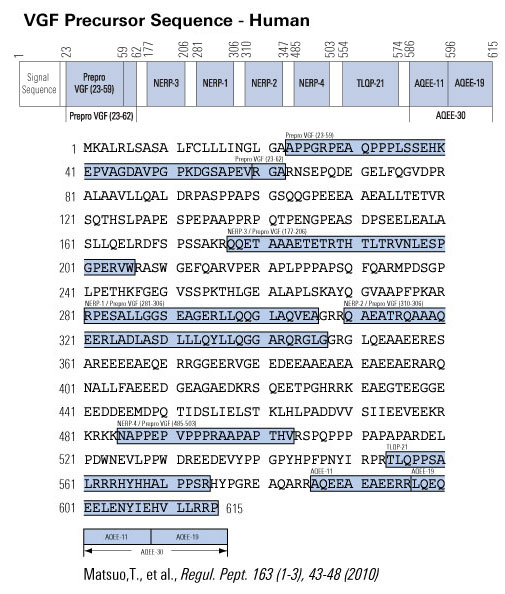
Peripheral tissue injury is associated with changes in protein expression in sensory neurons that may contribute to abnormal nociceptive processing. We used cultured dorsal root ganglion (DRG) neurons as a model of axotomized neurons to investigate early changes in protein expression after nerve injury. Comparing protein levels immediately after DRG dissociation and 24 h later by proteomic differential expression analysis, we found a substantial increase in the levels of the neurotrophin-inducible protein VGF (nonacronymic), a putative neuropeptide precursor. In a rodent model of nerve injury, VGF levels were increased within 24 h in both injured and uninjured DRG neurons, and the increase persisted for at least 7 d. VGF was also upregulated 24 h after hindpaw inflammation. To determine whether peptides derived from proteolytic processing of VGF participate in nociceptive signaling, we examined the spinal effects of AQEE-30 and LQEQ-19, potential proteolytic products shown previously to be bioactive. Each peptide evoked dose-dependent thermal hyperalgesia that required activation of the mitogen-activated protein kinase p38. In addition, LQEQ-19 induced p38 phosphorylation in spinal microglia when injected intrathecally and in the BV-2 microglial cell line when applied in vitro. In summary, our results demonstrate rapid upregulation of VGF in sensory neurons after nerve injury and inflammation and activation of microglial p38 by VGF peptides. Therefore, VGF peptides released from sensory neurons may participate in activation of spinal microglia after peripheral tissue injury.
Riedl MS, Braun PD, Kitto KF, et al. Proteomic analysis uncovers novel actions of the neurosecretory protein VGF in nociceptive processing. J Neurosci. 2009;29(42):13377-88.
The effect of five peptides derived from the C-terminal portion of rat pro-VGF (VGF(577-617), VGF(588-617), VGF(599-617), VGF(556-576) and VGF(588-597)) on penile erection was studied after injection into the hypothalamic paraventricular nucleus of male rats. VGF(577-617), VGF(588-617), VGF(599-617) and, to a lower extent, VGF(588-597) (0.1-2 microg) induced penile erection episodes in a dose-dependent manner when injected into the paraventricular nucleus, while VGF(556-576) was ineffective. VGF(588-617)-induced penile erection was reduced by nitro(omega)-L-arginine methylester (L-NAME; 20 microg), by morphine (5 microg) and by muscimol (1 microg), but not by dizocilpine [(+)MK-801; 1 microg], nor by cis-flupenthixol (10 microg) given into the paraventricular nucleus 10 min before the VGF peptide. d(CH2)5Tyr(Me)-Orn8-vasotocin (1 microg) effectively reduced VGF(588-617)-induced penile erection when given into the lateral ventricles but not when injected into the paraventricular nucleus. Immunocytochemistry with antibodies specific for the C-terminal nonapeptide sequence of pro-VGF (VGF(609-617)) revealed numerous neuronal fibres and terminals within the paraventricular nucleus, including its parvocellular components. Here, many immunostained neuronal terminals impinged on parvocellular oxytocinergic neurons. The present results show for the first time that certain pro-VGF C-terminus-derived peptides promote penile erection when injected into the paraventricular nucleus and suggest that, within this nucleus, these or closely related pro-VGF-derived peptides may be released to influence sexual function by activating paraventricular oxytocinergic neurons mediating penile erection.
Succu S, Cocco C, Mascia MS, et al. Pro-VGF-derived peptides induce penile erection in male rats: possible involvement of oxytocin. Eur J Neurosci. 2004;20(11):3035-40.
Social Network Confirmation